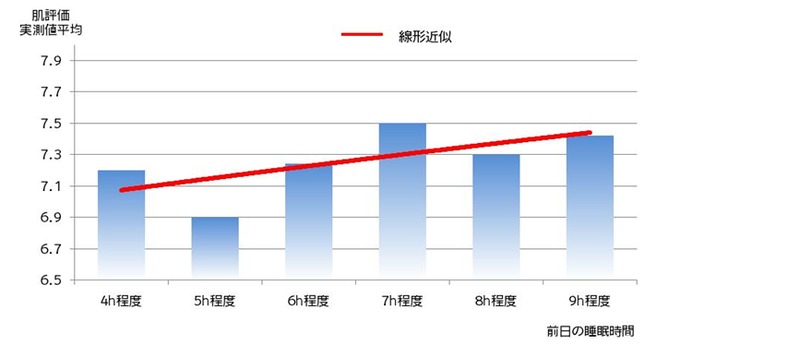In article #2, we wrote that " sensor data is the data that symbolizes the big data era." Indeed, signs of increased activity are emerging in marketing efforts using wearable devices equipped with sensor technology. Against this backdrop, Dentsu Inc., Fujitsu Limited (hereinafter Fujitsu), and Video Research Ltd. (hereinafter Video Research) conducted a survey to uncover the marketing value of sensor data. We present some of the results here.
The survey results are also available on the Video Research Ltd. website ( http://www.videor.co.jp/casestudies/research/custom/2013/01.htm ), so please take a look.
Analysis of the Relationship Between Skin-Related Awareness, Actual Measurement Values, and Lifestyle Attitudes
This survey, supervised by Video Research Ltd., involved distributing a smartphone app equipped with Fujitsu's skin condition sensor to survey participants (hereinafter referred to as "panel members"). It analyzed the relationship between the daily "actual measurements" obtained from the sensor and the difference between these measurements and the panel members' "perceived awareness" of their own skin condition, as well as the relationship with lifestyle attitudes.

[Survey Overview]
■Survey Period: Wednesday, November 13, 2013 - Monday, December 9, 2013
■Survey Participants: Women aged 20-49 residing in the Kanto region (Tokyo and 6 prefectures)
■Survey Method: Conducted daily for 26 days, involving two types of data collection.
・Questionnaire on daily activities (online survey)
・Photography and measurement using an app equipped with a skin condition sensor
■Valid Responses: 145 samples
First, we found a strong correlation between panelists' "self-reported perceptions" of their daily skin condition and the "average measured values" from the sensors.
Over the 26-day survey period, comparing the "self-perception" of panelists who rated their daily skin condition as "good or fairly good (Top 2)" or "poor or fairly poor (Bottom 2)" with the "actual sensor readings" showed a consistent correlation between these ratings and readings nearly every day (※1).
This result indicates that the "perception" of consumers' skin condition, which is normally invisible, can potentially be made "visible" using sensors.
(※1) Average measured skin evaluation values by self-reported evaluation

Furthermore, the correlation between daily lifestyle habits and skin condition was also visualized.
It is generally understood that daily skincare improves skin condition over the long term, and that daily living environments, such as sleep duration, affect the next day's skin condition.
Analyzing the panel's lifestyle attitude survey results alongside the "actual measurements" of skin condition obtained via sensors revealed that the average "actual measurement" values for panel members who performed skincare daily showed a gradual upward trend (※2).
(※2) Average measured skin evaluation values for panelists who performed skincare daily without fail

Furthermore, in the sleep duration analysis, we visualized a tendency (※3) where panelists with less sleep the previous day showed lower average "actual measurements" of skin condition.
(※3) Average actual skin evaluation measurements by previous night's sleep duration

Considering these results alongside the correlation between perception and actual measurements mentioned earlier, it can be inferred that daily skincare and living environments influence daily skin perception. To live brightly while feeling good about one's skin condition, maintaining good daily habits is likely crucial.
Interpreting Big Data Through Psychology
These analysis results further confirm the value of sensor data for advertising agencies as a means to enable "real-time visualization of daily consumer awareness through communication." Below is a diagram (created by the author) adapting the "Johari Window" concept from psychology, replacing "how others see me" with "how sensors see me." Designing communication grounded in psychology could enable more effective targeting across various domains.

For example, regarding the survey theme of "skin condition," in the "open" area ("what I know and the sensor knows about me"), message design using keywords like "familiar," "honest and easy," or "reassuring" might be effective. Conversely, in the "blind spot" area ("what the sensor knows that I don't"), message design that highlights the consumer's own gap could potentially enhance penetration.
As seen in the recent emergence of themes like "Big Data and Observation," combining seemingly disparate concepts like "Big Data and Psychology" could generate new ways for advertising agencies to utilize big data. We definitely want to continue discussions with psychology experts.
Of course, it's difficult to fully demonstrate the usefulness of sensor data based solely on this survey. However, as the broader marketing landscape shifts toward real-time and personalized approaches, wearable sensor data represents a valuable area for advertising agencies to seriously engage with.







